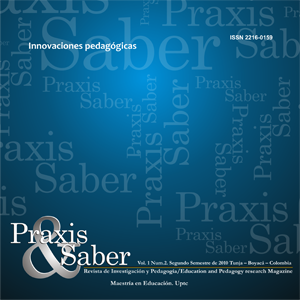Magic and a new pedagogical relationship with early childhood

Abstract
Based on the reflection about the practices of the author and in the light of the study of literature in relation to magic and pedagogical relationship, as well as several research projects, including her own Master’s Degree project in Education, this article analytically presents and develops four ideas: magic at the limits of modern science, as a cultural construction that has challenged reality and imagination, early childhood, as a dynamic process of the human being, linked to curiosity, exploratory power, audacity, possibilities of being and becoming, the early childhood educator as driving force of cognitive processes and learning environments, and finally, a new way to understand pedagogical relationship with preschoolers that arises from the critical examination of the previous information.Keywords
Preschool education, pedagogy, magic.
References
- Anónimo. La última palabra de la magia y del ocultismo . Buenos Aires. : Casa editorial Domingo Ferrari.
- Bethelheim, B. (1983). Psicoanálisis de los cuentos de hadas. Barcelona: Grupo editorial Grijalbo.
- Carr, S. K. (1988). Teoría Crítica de la Enseñanza. Barcelona- España: Edit Martínez roca .
- DINELLO, R. ( 2006). Pedagogía de la Expresión Ludocreativa. En Revista Internacional Magisterio, Educación y Pedagogía. Nº 19 .
- Freire, P. (2003). El Grito Manso. Buenos Aires Argentina: Siglo Veitiuno.
- Freire, P. (1999). Pedagogía de la autonomía. España: Siglo Veintiuno editores.
- FREIRE, P. (1993). Pedagogía de la esperanza. México: Siglo veintiuno editores.
- HUM, B. S. (20 de diciembre de 2001). Esquina mágica. Recuperado el 16 de julio de 2010, de www.esquinamágica.com.: www.esquinamágica.com.
- Kohan, W. (2009). Infancia y Filosofía. México D.F.: Progreso.
- KORSTANJE, M. U. (2009). Magia y estadística. Rituales sociales contra la incertidumbre. Revista de ciencias sociales nº 41, Universidad de Palermo Argentina .
- Meirieu, P. (2009). Aprender sí pero ¿cómo? Barcelona España: Octaedro.
- MEIRIEU, p. (2004). En la escuela de hoy. Barcelona: Octaedro.
- Meirieu, P. (1998). Frankenstein Educador. Barcelona: Laertes S.A.ediciones.
- NUÑEZ, V. (2003). Reinventar el vínculo educativo: aportaciones de la pedagogía Sociual y del psicoanálisis. Barcelona: Gedisa.
- Pineau, P., & Marcelo, D. I. (2005). La escuela como m{aquina de educar. Buenos Aires Argentina: Paidós - Cuestiones de educación.
- Quintar, E. B. (2006). La enseñanza como puente de vida. México: Pensamiento y cultura.
- RAWSON, C. (1978). El Gran Merlini. Como divertir a los niños con magia que usted puede hacer. México: Editorial Diana.
- REINERT, G.-B. (1984). La interacción pedagógica como aspecto de la acción del pedagogo práctico. EDUCACIÓN Collección semestral de aportaciones Alemans recientes en las ciencias pedagógicas. vol 29 , 62-85.
- ROCCA, V. (2006). Revista AISTHESIS,Nº 39 INSTITUTO DE ESTETICA DE LA UNIVERSIDAD CATOLICA DE CHILE. Recuperado el 18 de julio de 2010, de ”El giro Estético de la; La ficción como conocimiento, subjetividad y texto”: http://www.puc.cl/estetica/html/revista/pdf/Adolfo_Vssquez.pdf
- RYDELL, W. y. (1978). El gran libro de la Magia. Barcelona: Mundo actual ediciones, S.A.
- TAMAYO, A. (2009). Fundamentos epistemológicos de la Enseñanza, . Tunja: Universidad Pedagógica y Tecnológica de Colombia.
- TOULMIN, S. (1977). La comprensión humana vol 1 el uso colectivo y la evolución de conceptos. Madrid: editorial Alianza.
Downloads
Download data is not yet available.